The Paris Air and Space Museum is one of the world’s most important museums dedicated to aviation and space. Located in the historic Le Bourget airport, renovated according to the original design, the Musée de l’Air et de l’Espace houses a vast collection of hot air balloons, planes, rockets, and satellites. You can also board several planes, including a real 747 and two supersonic Concorde planes. In this article, you can find out what to see in the Paris Air Museum and how to organise your visit to enjoy it most, with or without children.
Table of Contents
What’s on at the Paris Air and Space Museum
Visiting the Paris Air and Space Museum is an incredible experience for all aviation and space enthusiasts. I have seen the museum several times, alone and with my son, and I have discovered something new each time. The museum is organised in time sections to find out how aviation has evolved over the centuries. The tour starts with the first balloon ascents and goes up to the conquest of space.
PLAN YOUR TRIP TO PARIS
Save money in Paris with the Paris City Card or the Paris Museum and Experiences Pass. Get free entry to major museums, climb the Eiffel Tower, and enjoy a Seine cruise and tourist bus.
To stay connected in France, remember to buy an Airalo eSim online, with data and phone coverage for your trip to Paris.
The new museum layout is spectacular because it unfolds on the restored airport designed by Georges Labro. The entrance to the museum is from the historic departure hall of Le Bourget airport, and the exhibition spaces expand on the runways and connected hangars.

The Air and Space Museum collection
The collection on display at the Air and Space Museum is extensive. It includes aircraft, helicopters, satellites, space rockets, and many other objects that have made history in aviation and space exploration. Among the more curious objects are hot air balloon-themed plates, popular when ascents were a popular spectacle. You can also see model airships and even a Zeppelin warship (read my article on the Zeppelin Museum in Friedrichshafen to learn all about Zeppelins).
The aircrafts
Moreover, one of the biggest attractions of the Musée de l’Air et de l’Espace is the hall dedicated to the Concorde. This Anglo-French supersonic aircraft revolutionised transatlantic air transport. The hangar displays two alongside planes: a prototype and a commercial plane. You can climb on it to see what the fastest plane in the world was like (spoiler: very uncomfortable!).
On the tarmac, the original take-off runway at the back of the museum, you can see an A380 airliner, the commercial aviation giant. Nearby are models of the Ariane I and Ariane V space rockets of the ESA (European Space Agency) and many other aircraft from different periods, both civil and military.
More to explore
On certain days of the week, which vary throughout the year, you can visit the control tower of Paris-Le Bourget airport for an extra charge. It, too, has been restored according to its original 1953 architecture. Finally, the museum hosts activities and temporary exhibitions ranging from art to engineering to explore and discover new aspects of aerospace transport.
Finally, inside the Musée de l’Air et de l’Espace, there is also a rich media library with a superb video room with first-class seats where you can discover the crafts of aviation through interviews with industry professionals and the development of trade routes with period films. Below, you can read about the museum’s best attractions, divided by subject area.
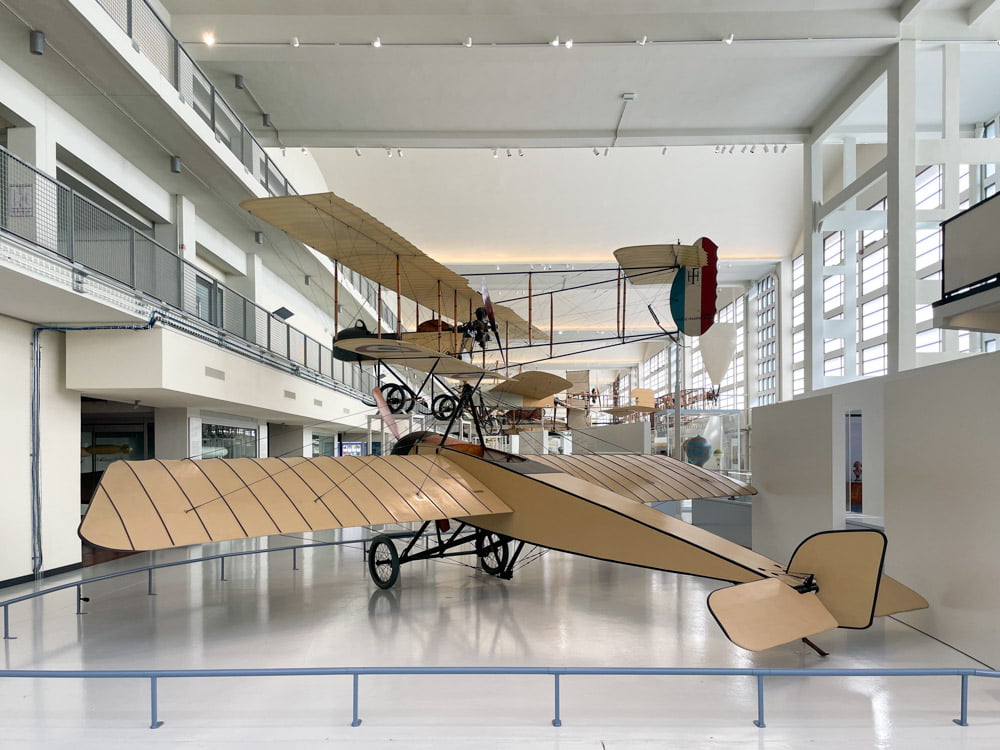
Birth of aviation
The Air and Space Museum in Paris offers an insightful journey through aviation history, initially just a hobby for a few enthusiasts. The first part of the museum showcases the technical characteristics and designs of the earliest aircraft, highlighting the evolution of aviation over time.
The most fascinating part of this section of the museum is the display of the excitement triggered by the first balloon ascents in 1783. During this era of ‘aéromanie’, various hot-air balloon gadgets were produced, including plates, jewellery and accessories. The balloon ascensions were great shows with gadgets designed for the events.
Warplanes
Military aviation research and development had a significant impact on the development of commercial aviation. The Air and Space Museum showcases a vast collection of warplanes, featuring various models of aircraft and biplanes from different periods.
Military aviation in the World War I
Until the World War I, aircraft were primarily a mechanical sport. On a military level, their use was almost exclusively for reconnaissance. However, shortly after the start of World War I, aircraft became a real weapon, changing the way of fighting and the role of military aviation.
From the beginning of World War I, air warfare started striking targets hundreds of kilometres away from the battlefields, even cities or industrial infrastructures, as we unfortunately know it still happens today.
The consequence was a significant investment in the creation of military aviation, but also in research and development, later applied to civil aviation, as you can see in the part of the exhibition dedicated to commercial aircraft produced between the two wars.
World War II aircraft and prototypes
The Paris Air and Space Museum hosts many aircraft used during World War II. It features several planes, including the Royal Air Force’s iconic fighter, the Supermarine Spitfire, and the Douglas C-47A Skytrain, also known as Dakota. In this room, visitors can also experience an interactive installation simulating the Normandy landings, which may not be suitable for young children due to its realistic nature.
The prototype hall showcases the technological advancements in aviation since World War II, including the transition from propeller-driven planes to modern jet planes. Visitors can explore attractions such as the Triton aircraft, the first French jet plane, the Leduc 010 experimental aircraft designed to take off from an aircraft carrier, and the Mirage III-V-01 aircraft, a prototype for vertical take-off and landing.
Lastly, the Cockade Room showcases the missions and professions of the modern military air force. This room displays equipment and vehicles for jet aircraft and peacetime rescue missions. It is an excellent opportunity to learn about military aviation’s positive impact.
Helicopters and gyrocopters
Helicopters and gyrocopters, an integral part of the civil and military aviation landscape, occupy an entire room of the Paris Air and Space Museum. I was intrigued to discover that what appeared to be the same aircraft model were two different types.
Both – helicopters and autogiros – are rotorcraft, namely aircraft that fly thanks to movable blades instead of fixed wings like aircraft. However, there are some crucial differences between helicopters and gyrocopters regarding operation.
The main difference is that helicopters use a main rotor to lift themselves and fly. In autogyros, on the other hand, the engine does not drive the main rotor. Still, it generates a forward thrust, as in aeroplanes. During flight, the propeller of autogyros only turns in autorotation with the force of the wind blowing on it.
In this area of the museum, you can see several historical models, such as Oehmichen’s N°6 helicopter from 1935, the Cierva C8-2 autogyro, the first to have crossed the English Channel, and the Alouette III of the Haute Montagne Gendarmerie squadron, which saved many lives during its time in mountain rescue missions.
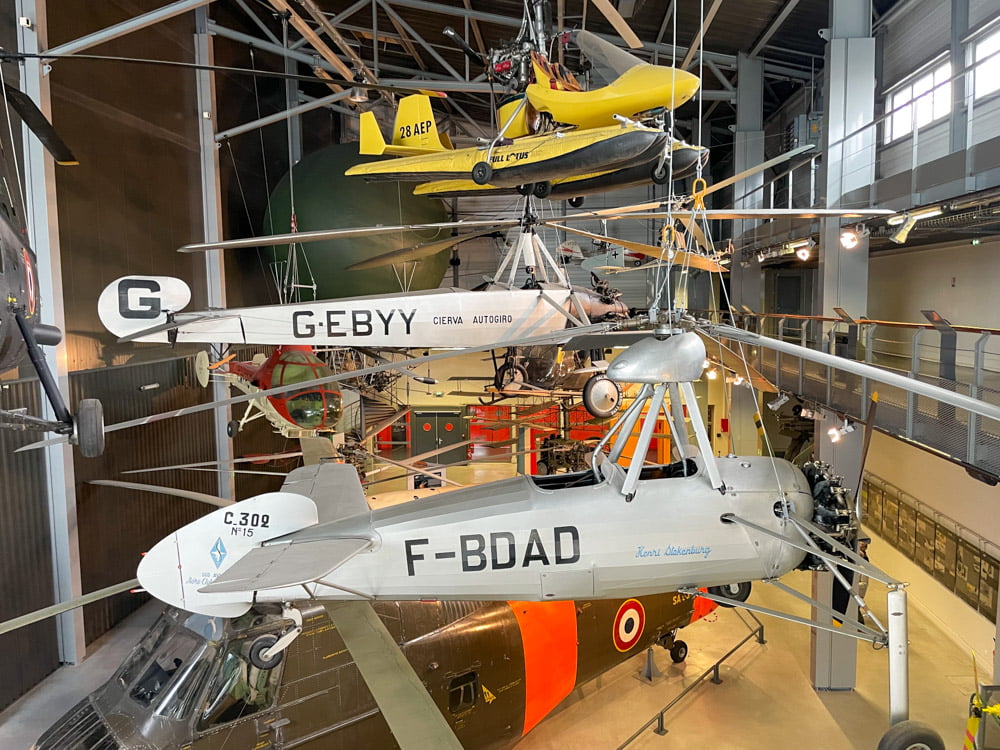
The conquest of space
The Air and Space Museum area dedicated to space conquest will surely leave you speechless. I remembered this part of the tour from my previous visit to the museum because it was truly memorable. The permanent exhibition shows space rockets and weather probes, with lots of scientific information about the missions.
The tour tells the story of humanity’s journey to space through the Ariane I and V sounding rockets, the Apollo missions, Sputnik and others. Among the highlights of this museum space are the Soyuz T-6 capsule and the space suit used by Jean-Loup Chrétien, the first Frenchman in space.
I was very impressed to discover the close ties between Russia (USSR) and France, also found later in the Normandie-Niemer pavillon. The space discovery project was closely linked to the collaboration between several countries, albeit born during the Cold War period.
Linked to the tensions between East and West, in the space conquest room, you can also see a documentary on nuclear weapons as a deterrent to war and discover the atomic experiments of France and other countries, allied and otherwise. Some of the missile bases built during the Cold War are still active.
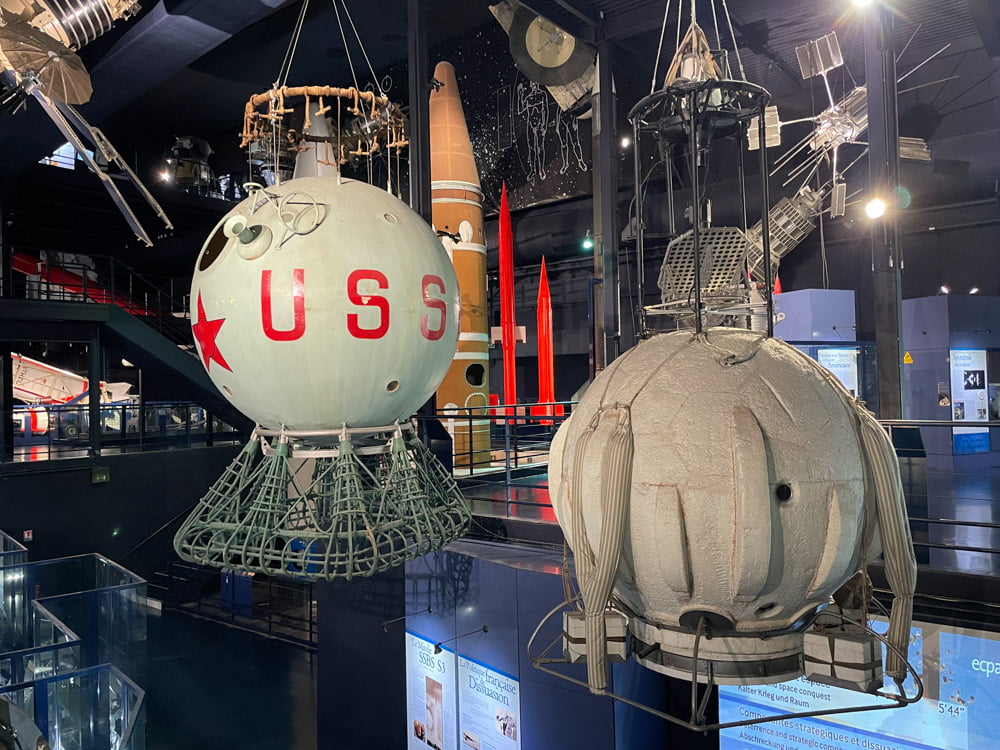
The Normandie-Niemen exhibition
Outside the museum building, a separate pavilion hosts an exhibition about the Normandie-Niemen regiment, a unit of the Free French Air Force engaged against the Nazis on the Russian front during World War II. The French pilots fought for more than two years on Soviet soil, and the exhibition recounts both the war campaigns and daily life at the front.
This unit has become a symbol of Franco-Russian friendship because Russian and French air force soldiers and mechanics fought and lived side by side for years, united despite the cold climate and cultural and language barriers. It is really impressive to see the clothing worn by the pilots.
The tarmac: aircraft and space rockets
The Air and Space Museum tarmac is the most spectacular part of the entire museum. On the tarmac, the areas of an airport where aircraft park, land, and take off, you can see civil and military aircraft and two life-size models of the Ariane I and Ariane V rockets, built by the European Space Agency (ESA), the Centre National d’Etudes Spatiales (CNES) and the company Arianespace at the Paris Air Show in 1979 and 1995.
Walking along the tarmac, you can discover how airliners, military transport aviation, and maritime patrolling have evolved from the 1950s to today. The main attractions are the Boeing 747 and Airbus A380 aircraft, which can be visited with the Boarding Pass included in the price (at the time of writing, the Airbus A380 was not yet accessible to the public).
There is also a yellow Canadair and several military aircraft. You can walk around all of them and see the various models’ differences in engines and sizes. It is certainly interesting to be in front of so many different aircraft simultaneously.

Boarding Pass: the ticket for boarding planes
The Boarding Pass, at the time of writing, included in the entrance ticket, allows you to board four aircraft and see what they look like up close. You can take a full tour of the Boeing 747, from the cockpit to the cargo hold, and experience a landing of the Douglas C-47 Dakota military aircraft through an interactive display, and board two Concorde aircraft, a prototype and a supersonic Air France airliner.
Boeing 747: full tour
Although few airlines left today use it for scheduled flights, you have almost certainly flown on a Boeing 747 at least once. Initially designed for Pan American in 1966, the Boeing 747 was the first wide-body aircraft for civil aviation. It remained in production for over 50 years.
The Boeing 747 is so important to aviation history because it revolutionised air transport by doubling the capacity of previous models. Because of its greater capacity, airports had to adapt to mass transportation.
What a Boeing 747 looks like
The model displayed on the museum’s tarmac is a 1972 Boeing 747-128 F-BPVJ that carried passengers for Air France until 2000, for 97,271 flight hours. The interior is not from the original plane but a specific layout designed to show the hidden parts of the aircraft, such as the structure, hold, cockpit, and passenger area.
I was amazed to see how the first class was not so luxurious compared to the seats in today’s planes. The cockpit was also tiny and uncomfortable. The most important part of the Boeing 747 is the cargo hold, which also allows you to load a car. That’s why cargo airlines widely utilised this model as a freight transport aircraft.
Half of the aircraft shows how oxygen, exhaust and electricity systems run on the floor, ceiling and along the walls. It is fascinating because these vital systems for aircraft operation are entirely hidden in the fitted cabin.
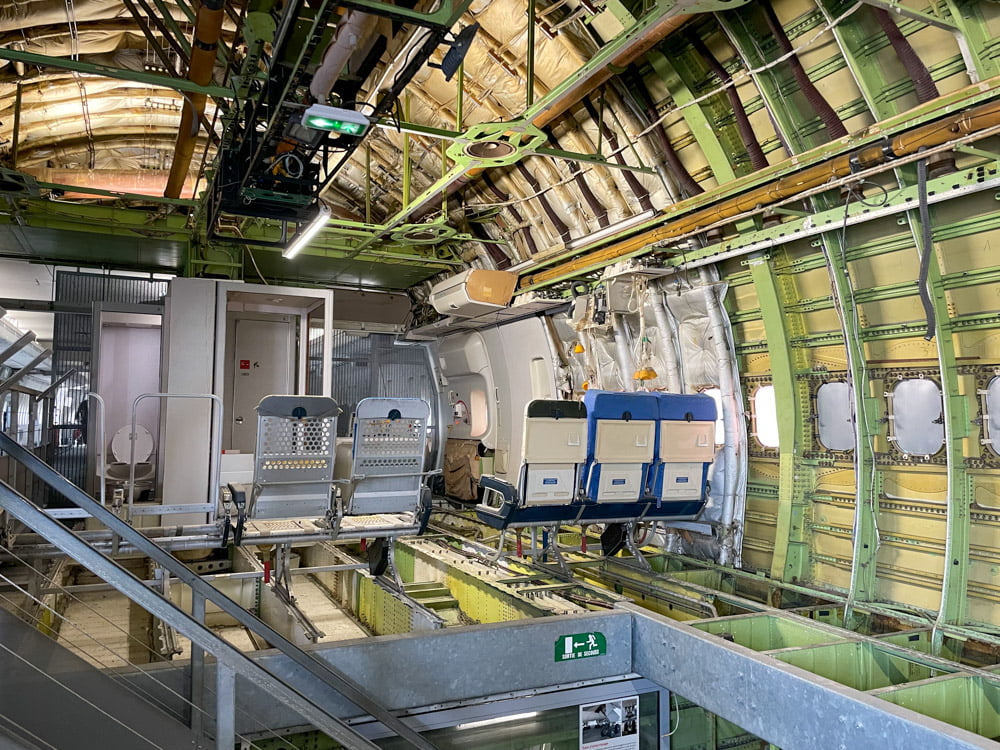
Douglas C-47 Dakota: simulated landing
Inside the military Douglas C-47A Skytrain Dakota aircraft in the World War II room, you can experience the landing through a multimedia experience. The idea is to recreate the reality of the war so that you can share it as if you were an Allied paratrooper.
The experience is realistic, with noise and vibrations. It’s not scary, but my four-year-old son didn’t like it very much because the loud noises and the recorded voices convey the excitement he experienced during the landing. In any case, go up and try it yourself.
Concorde: prototype and Sierra Delta
The Air and Space Museum in Paris is the only place in the world where you can visit two Concorde aircraft: the Concorde F-WTSS prototype and the Concorde F-BTSD Sierra Delta. A dedicated hangar near the tarmac hosts the two supersonic jets. To board the planes, however, you need a Boarding Pass, included in the museum entrance ticket at the time of writing.
The one-way tour allows you to climb up from the tail of one Concorde, cross over to the other by a gangway connecting the head doors, and then exit through the tail of the second plane. This part of the visit is exciting because you can discover in detail and see live the aircraft that made aviation history, travelling at speeds faster than the speed of sound.
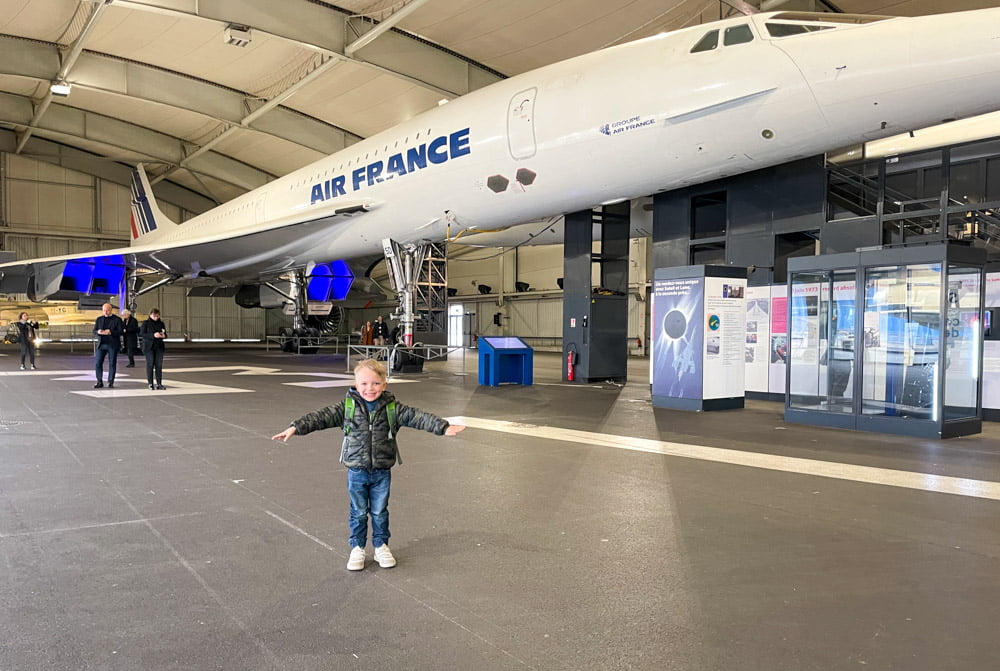
About the Concorde
The Concorde was a unique aircraft because it could fly at supersonic speed, which means it could fly above the speed at which sound propagates. When it reached supersonic speed, it broke through the wall of sound, making a characteristic ‘bang’ or sonic boom (also called a sonic roar).
Apart from the fascination of flying at supersonic speed, the Concorde made it possible to reach New York from London and Paris in three and a half hours instead of the more than eight hours it still takes today with ‘normal’ subsonic flights. However, it was unsuccessful because the operating and maintenance costs were exorbitant (and the aircraft uncomfortable).
The consortium producing Concorde, consisting of the French Aèrospatiale, today Airbus, and the British British Aircraft Corporation, merged into BAE Systems, produced only 20 aircraft, purchased by the respective national airlines Air France and British Airways. The biggest problem was that the Concorde needed 20 hours of maintenance for every hour of flight time.
It also consumed an average of 17 litres of fuel per passenger per 100 km. To give you a comparison, the A380, the largest passenger aircraft in use today that you can see on the museum runway, consumes only 3 litres of fuel per passenger per 100 km. Although fascinating, it was not a sustainable project.
Inside the Concorde
Seeing Concorde in person is a unique experience because it has left its mark on aviation history. Some of its technical features are unique, such as the tilted nose during landing, taxiing and take-off. The internal tour starts from the rear staircase of the Concorde prototype, crosses a gangway connecting the cabins of the two aircraft and ends by exiting the wing of the Concorde Sierra Delta.
My son and I greatly appreciated the Concorde because it could fly at supersonic speed. Still, I was surprised to discover how uncomfortable the plane was, with seats as cramped as today’s low-cost flights.
Concorde’s maintenance costs were excessive, and it was a commercial failure. Still, the technology that led to its development was genuinely incredible. The visit left us curious to discover the differences with the Soviet competitor Tupolev Tu-144, the only other supersonic airliner model ever built. Please write in the comments if you know where we can see it.
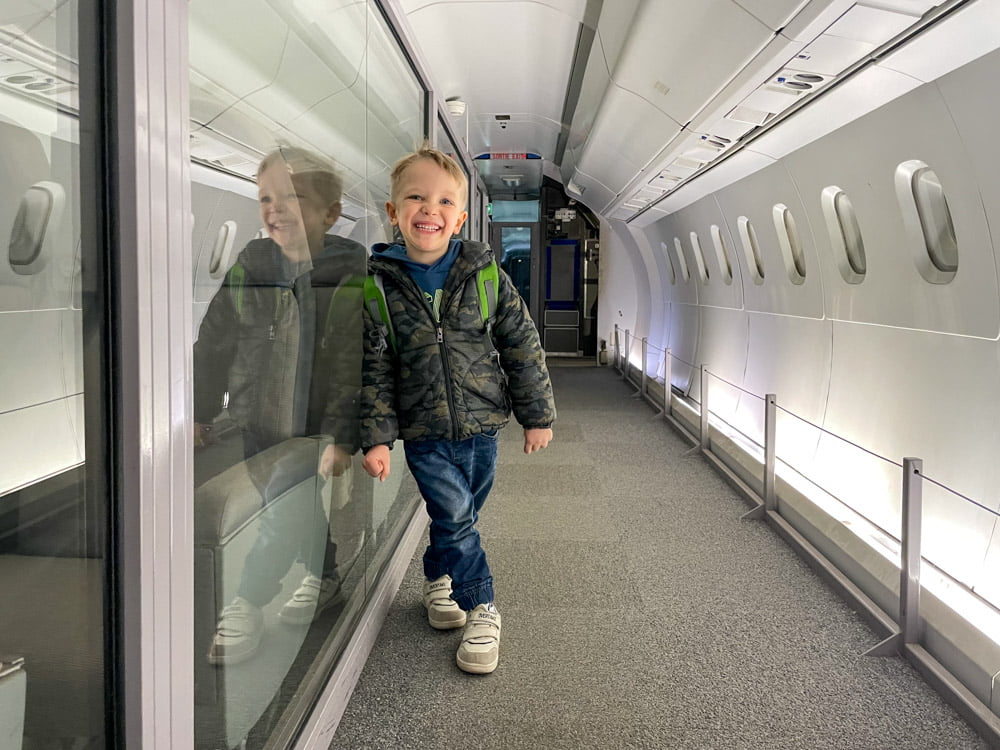
The history of the Air and Space Museum and Le Bourget Airport
Today, the Paris Air and Space Museum is one of the world’s most important museums dedicated to the history of aviation and space exploration.
Founded in 1919, it was initially an aeronautical conservatory. A hangar at Voisin in Issy-les-Moulineaux hosted the objects on display in the museum today, and the first exhibition occurred during the 6th International Air Show at the Grand Palais in Paris in the same year.
It was not until 1921 that it became a real aeronautical museum, the Musée de l’aéronautique in Chalais-Meudon, located in a former aerostatic workshop built during the Great War. Then in 1936, it moved to Paris, becoming the Musée de l’Air.
Paris Le Bourget Airport
In 1919, Le Bourget Airport became the first civil airport in Paris and opened its doors to the public. Today, only private flights land here, but it was one of the main Parisian airports in the last century. In Le Bourget Airport, Charles Lindbergh’s landing on the Spirit of Saint Louis in 1927 after the first non-stop transatlantic flight added to its significance.
Its Art Deco style, designed by architect Georges Labro, dates back to 1935. The refurbished department area now hosts the halls dedicated to aviation pioneers. However, the Air and Space Museum building is a post-war reconstruction, identical to Labro’s original design. Le Bourget Airport was almost destroyed by the Allies during World War II when it served as a German base in the part of France occupied by the Nazis.
Le Bourget Airport became the seat of the Air and Space Museum when air traffic reduced in 1970. Today, Paris Orly and Charles de Gaulle are the main Paris airports, and Le Bourget Airport is mainly a memory of the rich aviation history of Paris.
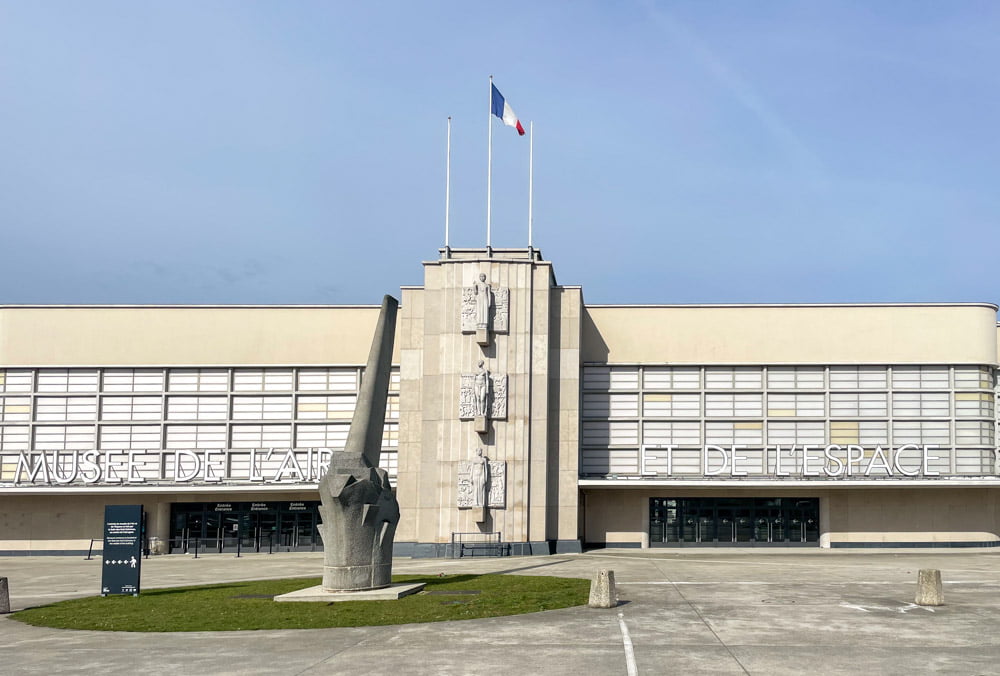
Practical information for visiting the Paris Air and Space Museum
In addition to private aircraft traffic, Le Bourget Airport has to remain available for domestic and extraordinary international air traffic, which is why the control tower is still operational. However, a large part of the tarmac hosts the permanent exhibition, while light touring aircraft use only a tiny area.
The Air and Space Museum is located in Le Bourget, a municipality outside Paris. There is no other attraction to see around, so if you dedicate the whole day to discovering aviation and space, you can eat inside the museum building.
L’Hélice restaurant offers a buffet menu with appetisers served in glass jars and hot dishes in cast-iron casseroles. The price and food at L’Hélice restaurant are excellent, so I recommend it. Alternatively, you can bring sandwiches to eat in the picnic area on the tarmac, overlooking the planes.
The Air and Space Museum in Paris with children
My child is very passionate about aviation. Whenever we go on trips, I include a visit to aviation and transport museums because of his interest. The museum has a vast collection of aircraft on display, and we were particularly impressed by its layout. The museum has interactive installations, such as flight simulators. Plus, you can even go inside real planes. We loved visiting different aircraft types, from the first biplanes to the supersonic Concorde.
If you’re planning a visit with young children, I recommend taking your time and not rushing through the exhibits. Devote a whole day to touring the museum, and eating at the in-house restaurant. This way, you can fully appreciate all the fascinating Air and Space Museum displays.
For older children aged six and up, there is the possibility of participating in workshops and some extra activities, such as the Planetarium or the Planète Pilote tour. At the time of writing, there were workshops in French on how hot air balloons work, aerospace communication, and air safety. If you are interested in extra activities and workshops, I suggest you check in advance the dates and times of the proposed activities on the museum’s website and whether reservations are necessary.
Paris Air and Space Museum opening hours
The Paris Air and Space Museum is open all year round, except Mondays, 1 January and 25 December. Hours are from 10 am to 5 pm during the winter period from October to March. From 10 am to 6 pm during the summer, with the last admission half an hour before closing time.
How much the Air and Space Museum tickets cost
At the time of writing, the entrance ticket to the Musée de l’Air et de l’Espace includes both the temporary exhibitions and the Boarding Pass to get inside the aircraft on display. The ticket for an adult costs €16, and children and young people under 18 pay €6.
However, I recommend you refer to the museum’s website to find out the exact cost of tickets in advance because sometimes temporary exhibitions are included. At the same time, there are reductions when it is impossible to access the tarmac due to ongoing events. Extra activities like the Planetarium, control tower tour, Planèt Pilote and workshops always have a separate cost, starting at €5. Admission to the museum is free on the first Sunday of the month.
How to get to the Air and Space Museum
A new metro line with a Musée de l’Air et de l’Espace stop for the Olympic games should open in 2026. At the time of writing, however, work is still in progress. Kindly let me know when you visit the museum so I can update the article.
The Musée de l’Air et de l’Espace can be reached in about half an hour from the centre of Paris (one hour from the surrounding areas) by city buses 350, 152 or 610, Musée de l’Air et de l’Espace stop. Depending on your starting point, you may have to take the metro, RER (city trains) or another bus. Check the best route on Google Maps because, again, due to metro works, there may be significant route variations.
Musée de l’Air et de l’Espace
Aéroport de Paris-Le Bourget
93352 Le Bourget
Where to stay in Paris
Sleeping in Paris can be expensive, prompting you to consider staying outside the city centre. In such a case, before selecting a hotel, I suggest you read my article on the best and worst neighbourhoods to stay in Paris.
I’ve visited Paris on several occasions for leisure and work, and I recommend a few places I’m familiar with. If you’re looking for a unique stay, Hôtel de Joséphine Bonaparte, built inside a 17th-century convent and located in the Marais district, is an excellent choice.
To save money, opt for the more affordable Hotel Bloum, situated close to the Opera and decorated with customised furnishings. Alternatively, the Aparthotel Adagio Paris Montmartre offers contemporary, self-catering apartments, perfect for families looking for more space in their rooms.
The Air and Space Museum in Paris is a must-see destination for aviation enthusiasts and families with children. I totally recommend it because the tour offers an immersive experience in the history of aviation and space exploration. Visitors can admire the vast collection of aircraft, rockets and spacecraft, learn about aviation technology and climb aboard real military and commercial aircraft. Feel free to comment if you already know about the Paris Air and Space Museum or if this article has inspired you to visit it alone or with children.
